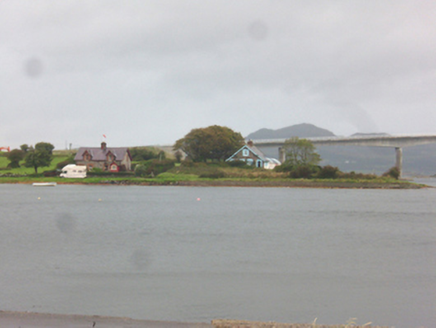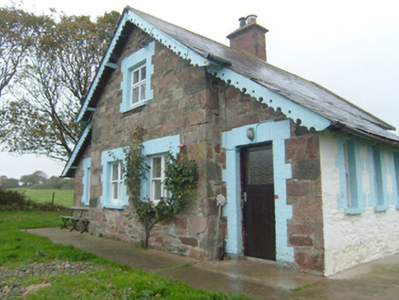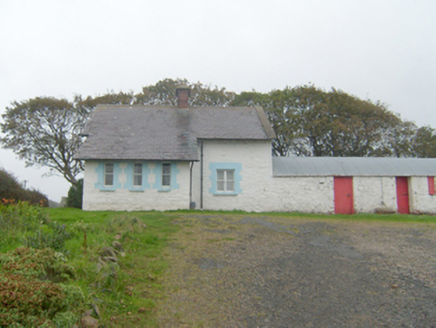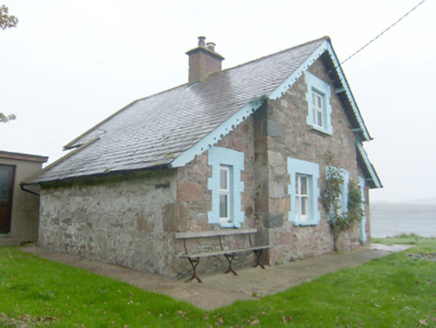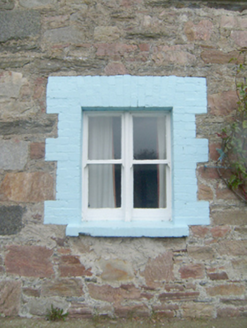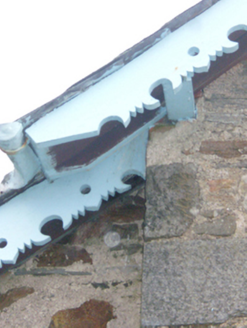Survey Data
Reg No
40901765
Rating
Regional
Categories of Special Interest
Architectural, Historical
Previous Name
Mulroy House
Original Use
Worker's house
In Use As
House
Date
1880 - 1900
Coordinates
215308, 437804
Date Recorded
04/10/2010
Date Updated
--/--/--
Description
Detached four-bay single-storey house with attic level, built c. 1890, having central two-bay breakfront to the south-east elevation with recessed bays to either side under continuous pitched roof, and with single-storey barrel-vaulted outbuilding attached to the north-west. Originally in use as a ferry house associated with Mulroy House (see 40901712), now in use as a private house. Pitched natural slate roof with central red brick chimneystack, raised rendered coping to the north-west gable end, overhanging eaves and exposed rafter ends, and with decorative pierced curvilinear timber bargeboards to front elevation (south-east). Roughly coursed rubble stone walls with evidence of lime render to rear, painted to the north-east side elevation. Square-headed window openings with painted brick block and start reveals and voussoirs, and mainly one-over-one pane timber sliding sash windows, paired at ground floor level to the front elevation. Some replacement windows. Square-headed doorway to the recessed by to the north-east end of the front elevation (south-east) having painted brick block and start reveals and voussoirs, and replacement glazed timber door. Attached six-bay single-storey outbuilding to the rear (north-west) having barrel-vaulted corrugated-metal roof, painted rubble stone walls, and square-headed window and door openings with battened timber fittings. Located in an elevated location towards the tip of Ferry Point overlooking Mulroy Bay to the south and east. Associated rubble stone piers adjacent to the north-east and across Mulroy Bay at Loughan\Leat Beg.
Appraisal
This attractive building, of late nineteenth-century date, was apparently originally built as a ferry house associated with Mulroy House (see 40901712) to the south. Despite some modern alterations, it retains much of its early form and character along with salient fabric including natural slate roof and timber sliding sash windows. Decorative interest is added by the attractive pierced curvilinear timber bargeboards to the front elevation, which are a feature of many of the estate buildings associated with the Mulroy estate. The contrast between the masonry and the brick detailing adds an attractive tonal and textural variation to the main elevations, which is again a feature of many of the buildings on the estate. The form of this building having central breakfront flanked to either side by recessed bays contained under the same roofline creates an attractive composition of some visual appeal. This building was apparently originally built as a ferry house associated with a ferry crossing over the short distance across Mulroy Bay to the Fanad Peninsula; the associated rubble stone piers survive to either side of this crossing (two along the Fanad shoreline to the north; see 40901771 for one of these piers) and add significantly to the historic setting and context. It was probably originally built for the Fourth Earl of Leitrim who greatly extended the main house, built numerous piers along Mulroy Bay (a process started by his predecessor in the 1870s) and added numerous estate buildings to the demesne between c. 1880 and c. 1890. A weekly cargo service was introduced by the Earl in 1883 calling at Portrush, Derry, Greenock and Glasgow, and there were also cargo services to Malin Head, Tory Island, and Kincasslagh. These steamers also carried passengers and livestock. By 1886 over 2,000 tonnes of potatoes were transported annually from Mulroy to Glasgow. The simple large-scale outbuilding to the rear of the house may have been associated with this trade, and it also adds to the historic context. This appealing building forms part of a group of structures associated with Mulroy House that together form the most extensive collection of their type surviving in Donegal, and is an integral element of the built heritage of the local area in its own rights. The simple boundary wall and wrought-iron gate add to the historic setting and context.
